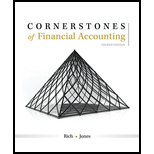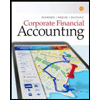
Concept Introduction:
Operating cycle:
Operating cycle is the chain of business activities performed in an organization. An organization can be manufacturing, servicing of merchandising type. For a merchandiser, the main business activities are the purchase, payment to the supplier, sales, and receipts from the customer. Hence the operating cycle of a merchandiser is limited as compared with the operating cycle of a manufacturer.
The Operating cycle mainly includes following activities:
•Purchases from the supplier (either cash or on account)
•Payment to suppliers
•Inventory
•Sales (either cash or on account)
•Collection from customer
The formula to calculate the operating cycle is as follows:
Net Operating Cycle = Inventory Period +
Requirement-1:
To Indicate:
The correct match for each business with its operating cycle description.
Concept Introduction:
Operating cycle:
Operating cycle is the chain of business activities performed in an organization. An organization can be manufacturing, servicing of merchandising type. For a merchandiser, the main business activities are the purchase, payment to the supplier, sales, and receipts from the customer. Hence the operating cycle of a merchandiser is limited as compared with the operating cycle of a manufacturer.
The Operating cycle mainly includes following activities:
•Purchases from the supplier (either cash or on account)
•Payment to suppliers
•Inventory
•Sales (either cash or on account)
•Collection from customer
The formula to calculate the operating cycle is as follows:
Net Operating Cycle = Inventory Period + Accounts Receivable Period − Accounts Payable Period.
Requirement-2:
To Indicate:
The effect of longer operating cycle on financial needs of the company.
Want to see the full answer?
Check out a sample textbook solution
Chapter 4 Solutions
Cornerstones of Financial Accounting
- RK Co. sells snowboards. Each snowboard requires direct materials for $140, direct labor for $55, and variable overhead of $64. The company expects fixed overhead costs of $673,000 and fixed selling and administrative costs of $160,000 for the next year. It expects to produce and sell 11,900 snowboards in the next year. What will be the selling price per unit if RK uses a mark-up of 17% of the total cost? Answerarrow_forward5 PTSarrow_forwardHii teacher please provide for General accounting question answer do fastarrow_forward
 Cornerstones of Financial AccountingAccountingISBN:9781337690881Author:Jay Rich, Jeff JonesPublisher:Cengage LearningCentury 21 Accounting Multicolumn JournalAccountingISBN:9781337679503Author:GilbertsonPublisher:Cengage
Cornerstones of Financial AccountingAccountingISBN:9781337690881Author:Jay Rich, Jeff JonesPublisher:Cengage LearningCentury 21 Accounting Multicolumn JournalAccountingISBN:9781337679503Author:GilbertsonPublisher:Cengage Financial Accounting: The Impact on Decision Make...AccountingISBN:9781305654174Author:Gary A. Porter, Curtis L. NortonPublisher:Cengage Learning
Financial Accounting: The Impact on Decision Make...AccountingISBN:9781305654174Author:Gary A. Porter, Curtis L. NortonPublisher:Cengage Learning Corporate Financial AccountingAccountingISBN:9781305653535Author:Carl Warren, James M. Reeve, Jonathan DuchacPublisher:Cengage Learning
Corporate Financial AccountingAccountingISBN:9781305653535Author:Carl Warren, James M. Reeve, Jonathan DuchacPublisher:Cengage Learning




